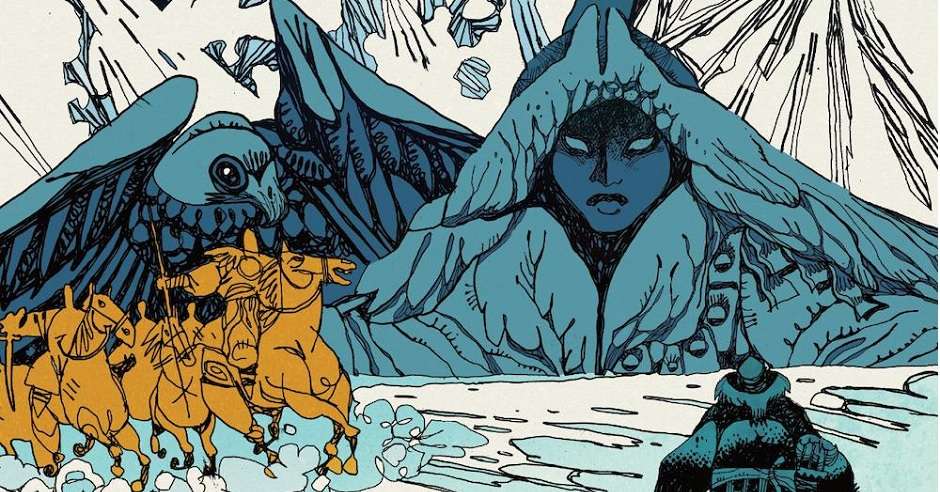We recently got a chance to speak with Dariel R.A. Quiogue about his sword & sorcery character Orhan Timur, sword & sorcery in general, and the crowdfunding campaign with New Edge Sword & Sorcery to release his new novella The Hunt of a Thousand Leagues.
[GDM] Thanks so much for taking the time for this interview. Can you tell us who you are and what sorts of stories you write?
[DQ] Hi Alex, and thanks for the interview. I’m Dariel Quiogue, I used to do commercial photography work and wrote for some magazines, but well before that I was a fan of fantasy and science fiction. Getting introduced to Star Wars, Conan the Cimmerian and John Carter all in the same year (1977) kinda warped my brain, so I guess it was kinda inevitable I’d write fantasy and science fiction in the pulp tradition.
[GDM] The Hunt of a Thousand Leagues is not your first tale with Orhan Timur. I first read him back in New Edge Sword and Sorcery Issue 0 with your story “The Curse of the Horsetail Banner” (which was really good, by the way!). Where did Orhan come from? How has writing him changed from story to story?
[DQ] The first Orhan story was “Lord of the Brass Host”, which first appeared in Heroic Fantasy Quarterly #7 (it’s still free to read on their site, and also appears in their Best Of Volume 1 and my Swords of the Four Winds collection). The inspiration for that was the Terra Cotta Army that was found in the tomb of China’s first emperor, Qin Shih Huang Di; as I was looking at the photos I started to imagine what if these were clockwork automata? I needed a protagonist to pit against the clockwork army, and since the setting was going to be a fictional North China frontier city, I thought a character of Mongolian-inspired origin fit the bill best.
To give the character extra spice, I set him up as an alternate-world version of Chingis Khan, who had just been overthrown by his former friend and sworn brother, the equivalent for the historical Jamuqa. I was aiming to make Orhan Timur a series character from the very first, so I wanted a hook that could be used again and again in many variations.
I wrote that first story in 2013. I guess I’m changing as a person, and I’m also looking for new angles for this character, so this reflects in the newer Orhan stories. I’m exploring his origins more, getting deeper into Mongol history and culture, and I guess writing more of him, specially in longer formats, lets me explore his humanity. He can be a cold-hearted badass, but he’s also got his ties and dreams.
[GDM] Orhan and his stories are inspired by and take place within Mongolian culture. What got you interested in the subject and what is it that you enjoy about it?
[DQ] I’ve always been interested in the history and culture of the Eurasian steppe nomads – the freedom of life on the wide open steppe, which was a great highway between cultures rather than a barrier, you could have a character get on a horse in Xinjiang in one adventure and end up on the shores of the Caspian in the next one. I’ve also got this thing with what I call ‘Forgotten Asia,’ Asia from the Chinese border west to Persia and from Siberia south to the Southeast Asian archipelagoes – you find a lot of English-language media inspired by China and Japan, but very little in Forgotten Asia.
So when I was coming up with my first stab at writing and publishing fiction, I came up with the title Swords of the Four Winds, a book that would explore this Forgotten Asia and also as a homage to an author I consider a mentor of sorts, Harold Lamb. I first read Lamb’s Babur the Tiger while living in Delhi, actually found my copy in a bookstall within view of the Red Fort so that was really appropriate, then devoured his other histories and biographies in the school library. All that of course got me even more interested in the steppe peoples.
[GDM] While most S&S stories are episodic in nature—with the reader being able to pick them up at any point in a character’s saga—is there an arc that you’re working towards with Orhan?
[DQ] Not really. The changes in Orhan’s personality are organic, and since I’ve been writing tales of his earlier adventures, he’s almost two different characters. In the interests of consistency though I always try to be sure where an Orhan story in production would have occurred in relation to his other stories. Recently, because there are now too many tales to easily keep track in my head, I wrote down a rough sequence on my blog.
Readers new to Orhan Timur can start anywhere in the sequence, they’re all self-contained and episodic, but for the curious, Hunt of a Thousand Leagues occurs several years after the events in “Curse of the Horsetail Banner” (New Edge of Sword and Sorcery #0), and a year or two before the events in “Battle of the Nine Waters” (New Edge of Sword and Sorcery #4).

[GDM] Where do we find Orhan in the beginning of The Hunt of A Thousand Leagues?
[DQ] The Hunt of a Thousand Leagues finds Orhan Timur, betrayed while plotting a rebellion against his rival and usurper Jungar, fleeing for his life then mortally wounded. Even as he’s dying, the only thing on his mind is revenge … and Things Happen when the Snow Leopard is in a bad mood!
‘Hunt’ has ended up as an exploration of the culture of vendetta – its pervasiveness, how it warps relationships and the price for engaging in it, even while it’s considered a form of justice and even spiritual obligation. Orhan starts the chain, wanting revenge on his betrayers, but that only leads to others declaring vendetta on him!
[GDM] Do you have lots of other Orhan stories you’ve tried writing or have ideas for?
[DQ] More like there are a lot more historical hooks, nooks and crannies I want to explore with Orhan Timur as my lens. Most of my S&S stories are inspired by history and real-world cultures – you can’t get any weirder than what humankind has already done in thousands of years of history. So in one recently written story I had Orhan Timur meet my world’s equivalent of the Varangians, who in the real world were actively trading and raiding around the Black and Caspian Seas from Russia.
[GDM] What were some of your first sword & sorcery stories that got you into the genre? Is there a specific S&S character or story trope that you’re really fond of?
[DQ] In a way my very first S&S read was Homer’s Odyssey (in an abridged prose version of course). I was an asthmatic bookworm as a kid, and when I found our family copy of that I devoured it. Exposure to Conan, first through the pastiches of de Camp, Carter and Nyberg, merely sharpened the taste I’d already acquired through The Odyssey and Ray Harryhausen movies for swashbuckling adventure in faraway lands.
I also acquired, through my father’s collection of military histories, a fascination with warfare. He had a battered old copy of Hemingway’s Men at War collection, that was specially seminal for me. That, plus Tolkien’s vivid descriptions of battles in Lord of the Rings, spurred me to often include battle scenes in my stories. The Orhan Timur tales get more of those, he’s modeled on Chingis Khan so of course I portray him (or try to) as a military genius.
[GDM] The Hunt of a Thousand Leagues is part of a larger funding campaign with Brackenbury Books. You’ve worked with them before, for both New Edge Sword & Sorcery and Double-Edged Sword & Sorcery. Can you talk about what that experience has been like?
[DQ] It’s been a great pleasure and eye-opener into the indie publishing world. For one thing, it’s taught me that I’m better off producing stories and finding publishers for them rather than trying to be a one man show. And Oliver Brackenbury is for me a fantastic person to collaborate with, really professional and at the same time a real fan of the genre. Working with Bryn Hammond has also been great, her encyclopedic knowledge of Mongol culture is reshaping Orhan and the Orhan stories.
[GDM] What are you reading now?
[DQ] Nothing at the moment, but I’ve just recently finished Harry Turtledove’s Krispos of Videssos trilogy.
[GDM] Do you have any other projects that you’re working on and can talk about? Do you have anything coming out soon that we should look out for?
[DQ] I’m planning to spend most of 2026 writing stories for a second volume of Swords of the Four Winds, and planning a wider re-release, with more art, of the first volume. So look for those in 2027, and keep an eye on out Brackenbury Books’ updates.
Dariel’s novella—as well as the other novellas in the crowdfunding campaign—can be found on BackerKit.

